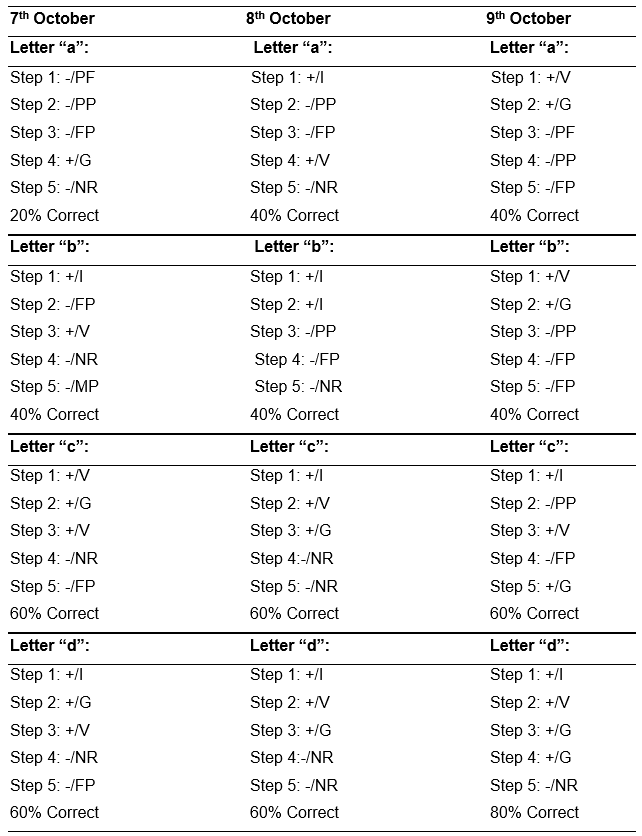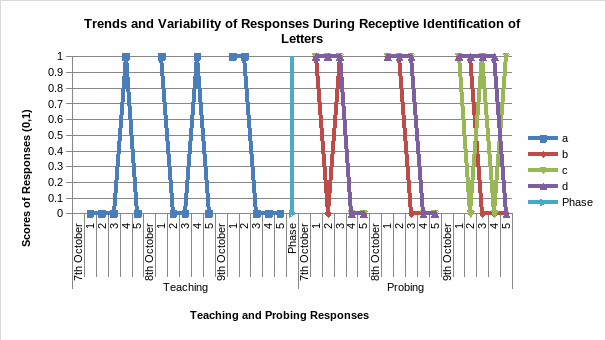Introduction
The program used in performing discrete trial training (DTT) is called “Receptive Letter Identification.” Discriminative stimuli (Sd) used to trigger responses were letters, namely, “a”, “b”, “c”, and “d”. The student identified each letter by following five series of steps with a progressive level of distraction. In the first step, the student was presented with a single letter in the absence of distractors or other stimuli.
The second step entailed the identification of the letter in the presence of a distracting stimulus. Subsequently, in the third step, the student identified the letter in the existence of two additional distracting stimuli. Progressively, in the fourth step, the student identified the presented letter among the other three distracting stimuli. In the fifth step, the student identified the presented letter in the absence of distracting stimuli. The procedure was repeated for each letter, and the ability of students to discriminate stimuli was noted and scored.
The Board Certified Behavior Analyst (BCBA) supports the application of the program in the behavioral analysis. The identification of figures, colors, objects, parts, and letters enables students to create correlations, respond to prompts, and master their receptive abilities. In this case, the identification of letters plays a central role in the learning process of students because it forms the basis of literacy and discrimination of different words, objects, and figures.
For instance, if a teacher asks students to identify a letter with a particular sound, they will be able to discriminate them amongst other distracting letters, leading to the development of literacy and numeracy skills.
Moreover, the program will enable students to identify shapes and sounds associated with patterns depicted by letters. The baseline assessment of students performed at the beginning of the year demonstrated that students would be ready to identify colors, shapes, figures, objects, and letters within 6-12 months after the completion of essential learning objectives. Given that the baseline assessment noted that the identification of letters requires advanced skills for their age group, the BCBA recommended the implementation of a customized curriculum to enable them to keep abreast of the receptive identification of letters.
Data Collected
The program allowed the student to exhibit mastery of receptive identification of letters through the five steps described above. In each step, the student scored a maximum of 20%, adding to 100% for five steps. Responses that depicted independent (I), verbal (V), and gestural (G) prompts were assigned “+” with a score of 20%, whereas those that exhibited model prompt (MP), partial physical (PP), full physical prompt (FP), and no response (NR) had no score (“-“). In three consecutive days, namely, 7th, 8th, and 9th, the student took part in the program, identified letters (a-e), and generated the following data in Table 1.

Prompt Hierarchy
Before the commencement of the program, teachers taught students and prepared them using the most-to-least prompting method of errorless learning to eradicate potential errors during the first three months. The assessment of students during this period showed that they were not responsive to discriminative stimuli because they exhibited avoidance behaviors such as tantrums and escapism. These behaviors necessitated reinforcement using 1-1 contingency discriminative stimuli. The program changed the approach during the fourth-month by transitioning to DTT and applying the most-to-least form of prompt grading.
As further assessment indicated that students improved the accuracy of their responses, reinforcement was increased to 3-1 contingency. Consequently, the discriminative prompts declined; it required the reverse application of prompt hierarchy. Therefore, the program switched prompt hierarchy from the decreasing to increasing order of the least-to-most prompt with the assumption that students would respond punctually to the discriminative stimuli. Surprisingly, students demonstrated that they could identify letters independently without verbal and gestural prompts.
Visual Representation
Data: Legend

Trend/Variability/Level
The analysis of trends and variability of responses (Figures 1 and 2) provided essential information about the receptive identification of letters. The letter “b” was presented to the student after undergoing appropriate training and gaining an adequate level of motivation to engage in the program. The graph (Figure 1) shows that the student depicted variability in the identification of the letter during the first day.
Precisely, the student managed to identify the letter in the first step independently but with a verbal prompt in the third step with two distractors. During the second and the third days, the identification of the letter displayed a downward trend without variability. On the second day, independent prompts enabled the student to identify the letter during the first and second steps but failed to identify it in the third, fourth, and fifth steps.
Likewise, during the third day, verbal and gestural prompts assisted the student to recognize the letter but did not recognize it at the third, fourth, and fifth steps despite partial and full physical prompts. Overall, the analysis of the trend of responses shows that independent, verbal, and gestural prompts enabled the student to detect the letter in the absence or presence of a competing stimulus, while distractors prevented identification.
The identification of the letter “c” showed a declining trend in the graph without variability. During the first day, the student identified the letter with the help of verbal, gestural, and verbal prompts in the first, second, and third steps, respectively. In the second day, independent, verbal, and gestural prompts assisted the student in identifying the letter in the first, second, and third steps correspondingly. During the third day, responses exhibited variability in the identification of the letter. On the first day, the student identified the letter in the first, the third, and the fifth steps with the help of independent, verbal, and gestural prompts, respectively.
However, the student failed to identify the letter in the second and fourth steps irrespective of partial and full prompts. The existence of variability emanates from avoidance behaviors since the student was intermittently playing with learning kits during the session. Thus, the use of reinforcement enabled the student to concentrate during the session and succeeded in identifying the presented letter with verbal and gestural prompts.
The identification of the letter “d” exhibited a declining trend without apparent variability in responses across the three days. During the first day, the student recognized the letter in the first through the third day with the aid of independent, gestural, and verbal prompts in that order. In the second day, independent, verbal, and gestural prompts enabled the student to identify the letter in the first, second, and third days respectively.
During the third day, the student scored the highest scores because he consecutively recognized the letter with the assistance of independent, verbal, gestural prompts. Since the student concentrated on the work and had an adequate level of motivation, he managed to identify the presented letter.